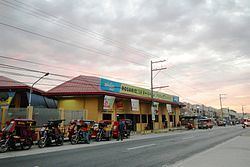District 2nd District Barangays Area 73.98 km² Local time Thursday 2:37 AM | Founded 1869 Time zone PST (UTC+8) Area code 72 Population 52,679 (2010) Dialling code 72 | |
 | ||
Weather 26°C, Wind S at 3 km/h, 82% Humidity | ||
Trip to ilocos via rosario la union
Rosario (Ilocano: Ili ti Rosario, Pangasinan: Baley na Rosario) is a first class municipality in the province of La Union, Philippines. According to the 2010 Philippine census, it has a population of 52,679 people, with average annual income of Php 86,125,676.88. It has a land area of 7,398 hectares (18,280 acres).
Contents
- Trip to ilocos via rosario la union
- Map of Rosario La Union Philippines
- Sunog sa rosario la union
- Etymology
- History
- Local Government
- Tourism
- 1869 Immaculate Concepcion Parish Church
- References
Map of Rosario, La Union, Philippines
The Kennon Road starts from this town and ends at Baguio City. It is being proposed that this town will be the terminus of the Tarlac-Pangasinan-La Union Expressway. Rosario is 215 kilometres (134 mi) away from Metro Manila. Rosario links Ilocos and Cordillera Provinces. The flight distance between Manila and Rosario is 189 km.
Sunog sa rosario la union
Etymology
Rosario came from the phrase “rosas del rio” (beautiful landscape with narrow valleys, wild animals, birds, rivers, brooks, dense forest and riverscape, as discovered by Spaniards). Another version or story, is that the long range of foothill far west of the Poblacion appearing like big Rosary beads was source of the town's name (giant and long rocky rosary).
Rosario is the southernmost town of La Union and the Ilocos Region, hence called the “Gateway to Ilocandia”. Rosario's national highway passes along a mountain at barangay Agat (of Sison, Pangasinan), then into the Bued bridge (the boundary marker between La Union and Pangasinan).
History
Rosario was formerly a part of Santo Tomas and became a municipality in 1869 by a decree. Natives of Rosario emanated from Santo Tomas and Magsingal (Ilocos Sur), and also from Agoo, Tubao, Aringay, San Fernando and Bacnotan.
It was Don Mariano Posadas, Don Mariano Narcelles and Don Gavino Ordoña, who filed a petition with the authorities for conversion of Rosario to a town from sitio or barangay. In 1869, the Spanish Provincial Governor created Rosario town and appointed Don Agustin Isidro de Guzman as its first Capitan Municipal.
Local Government
Just as the national government, the municipal government of Rosario, is divided into three branches: executive, legislative and judiciary. The judicial branch is administered solely by the Supreme Court of the Philippines. The LGUs have control of the executive and legislative branch.
The executive branch is composed of the mayor and the barangay captain for the barangays.Local Government Code of the Philippines, Book III, Department of Interior and Local Government official website.
The legislative branch is composed of the Sangguniang Bayan (town assembly), Sangguniang Barangay (barangay council), and the Sangguniang Kabataan for the youth sector.
The seat of Government is vested upon the Mayor and other elected officers who hold office at the Pugo Town hall. The Sanguniang Bayan is the center of legislation, stationed in Rosario Legislative Building or Town hall.
Tourism
Rosario has the following landmark attractions:
1869 Immaculate Concepcion Parish Church
The Immaculate Concepcion Parish Church was canonically erected in 1869. It is under the jurisdiction of the Roman Catholic Diocese of San Fernando de La Union (Dioecesis Ferdinandopolitana ab Unione, Suffragan of Lingayen – Dagupan, which was created on January 19, 1970 and erected on April 11, 1970, comprising the Civil Province of La Union, under the Titular, St. William the Hermit, February 10). The Church is under a diocese of the Latin Rite of the Roman Catholic Church in the Philippines from the Archdiocese of Nueva Segovia.
The Rosario Church is under the Vicariate of St. Francis Xavier with Vicar Forane, Fr. Joel Angelo Licos. Its Parish Priestis Fr. Raul S. Panay.
The church is located at the eastern side fronting the National Highway and the Municipal Building. It has an access road to the Rosario-Pugo-Baguio Road.
